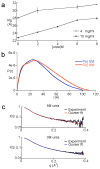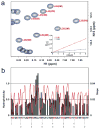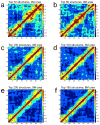Understanding the structural ensembles of a highly extended disordered protein
- PMID: 21979461
- PMCID: PMC3645981
- DOI: 10.1039/c1mb05243h
Understanding the structural ensembles of a highly extended disordered protein
Abstract
Developing a comprehensive description of the equilibrium structural ensembles for intrinsically disordered proteins (IDPs) is essential to understanding their function. The p53 transactivation domain (p53TAD) is an IDP that interacts with multiple protein partners and contains numerous phosphorylation sites. Multiple techniques were used to investigate the equilibrium structural ensemble of p53TAD in its native and chemically unfolded states. The results from these experiments show that the native state of p53TAD has dimensions similar to a classical random coil while the chemically unfolded state is more extended. To investigate the molecular properties responsible for this behavior, a novel algorithm that generates diverse and unbiased structural ensembles of IDPs was developed. This algorithm was used to generate a large pool of plausible p53TAD structures that were reweighted to identify a subset of structures with the best fit to small angle X-ray scattering data. High weight structures in the native state ensemble show features that are localized to protein binding sites and regions with high proline content. The features localized to the protein binding sites are mostly eliminated in the chemically unfolded ensemble; while, the regions with high proline content remain relatively unaffected. Data from NMR experiments support these results, showing that residues from the protein binding sites experience larger environmental changes upon unfolding by urea than regions with high proline content. This behavior is consistent with the urea-induced exposure of nonpolar and aromatic side-chains in the protein binding sites that are partially excluded from solvent in the native state ensemble.
Figures





Similar articles
-
Phosphorylation Regulates the Bound Structure of an Intrinsically Disordered Protein: The p53-TAZ2 Case.PLoS One. 2016 Jan 7;11(1):e0144284. doi: 10.1371/journal.pone.0144284. eCollection 2016. PLoS One. 2016. PMID: 26742101 Free PMC article.
-
Multiscale ensemble modeling of intrinsically disordered proteins: p53 N-terminal domain.Biophys J. 2011 Sep 21;101(6):1450-8. doi: 10.1016/j.bpj.2011.08.003. Epub 2011 Sep 20. Biophys J. 2011. PMID: 21943426 Free PMC article.
-
Molecular Dynamics Simulations Combined with Nuclear Magnetic Resonance and/or Small-Angle X-ray Scattering Data for Characterizing Intrinsically Disordered Protein Conformational Ensembles.J Chem Inf Model. 2019 May 28;59(5):1743-1758. doi: 10.1021/acs.jcim.8b00928. Epub 2019 Mar 18. J Chem Inf Model. 2019. PMID: 30840442 Review.
-
Recognition of the disordered p53 transactivation domain by the transcriptional adapter zinc finger domains of CREB-binding protein.Proc Natl Acad Sci U S A. 2016 Mar 29;113(13):E1853-62. doi: 10.1073/pnas.1602487113. Epub 2016 Mar 14. Proc Natl Acad Sci U S A. 2016. PMID: 26976603 Free PMC article.
-
Structural analysis of intrinsically disordered proteins by small-angle X-ray scattering.Mol Biosyst. 2012 Jan;8(1):151-67. doi: 10.1039/c1mb05275f. Epub 2011 Sep 22. Mol Biosyst. 2012. PMID: 21947276 Review.
Cited by
-
Impact of the K24N mutation on the transactivation domain of p53 and its binding to murine double-minute clone 2.Proteins. 2013 Oct;81(10):1738-47. doi: 10.1002/prot.24310. Epub 2013 Jul 22. Proteins. 2013. PMID: 23609977 Free PMC article.
-
Quantitative prediction of ensemble dynamics, shapes and contact propensities of intrinsically disordered proteins.PLoS Comput Biol. 2022 Sep 9;18(9):e1010036. doi: 10.1371/journal.pcbi.1010036. eCollection 2022 Sep. PLoS Comput Biol. 2022. PMID: 36084124 Free PMC article.
-
Clustering Heterogeneous Conformational Ensembles of Intrinsically Disordered Proteins with t-Distributed Stochastic Neighbor Embedding.J Chem Theory Comput. 2023 Jul 25;19(14):4711-4727. doi: 10.1021/acs.jctc.3c00224. Epub 2023 Jun 20. J Chem Theory Comput. 2023. PMID: 37338049 Free PMC article.
-
Reweighting methods for elucidation of conformation ensembles of proteins.Curr Opin Struct Biol. 2022 Dec;77:102470. doi: 10.1016/j.sbi.2022.102470. Epub 2022 Sep 29. Curr Opin Struct Biol. 2022. PMID: 36183447 Free PMC article. Review.
-
A lowly populated, transient β-sheet structure in monomeric Aβ1-42 identified by multinuclear NMR of chemical denaturation.Biophys Chem. 2021 Mar;270:106531. doi: 10.1016/j.bpc.2020.106531. Epub 2020 Dec 24. Biophys Chem. 2021. PMID: 33453683 Free PMC article.
References
-
- Wright PE, Dyson HJ. J Mol Biol. 1999;293:321–331. - PubMed
-
- Daughdrill GW, Pielak GJ, Uversky VN, Cortese MS, Dunker AK. In: Protein Folding Handbook. Buchner J, Kiefhaber T, editors. Vol. 3. WILEY-VCH; Darmstadt: 2005. pp. 275–357.
-
- Vendruscolo M. Curr Opin Struct Biol. 2007;17:15–20. - PubMed
-
- Uversky VN. Eur J Biochem. 2002;269:2–12. - PubMed
Publication types
MeSH terms
Substances
Grants and funding
LinkOut - more resources
Full Text Sources
Research Materials
Miscellaneous

